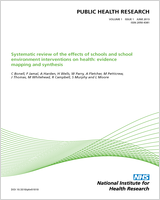Included under terms of UK Non-commercial Government License.
NCBI Bookshelf. A service of the National Library of Medicine, National Institutes of Health.
Crombie IK, Falconer DW, Irvine L, et al. Reducing alcohol-related harm in disadvantaged men: development and feasibility assessment of a brief intervention delivered by mobile telephone. Southampton (UK): NIHR Journals Library; 2013 Sep. (Public Health Research, No. 1.3.)

Reducing alcohol-related harm in disadvantaged men: development and feasibility assessment of a brief intervention delivered by mobile telephone.
Show detailsIntroduction
The overall objective of this feasibility study was to develop and test the feasibility of an intervention delivered by text messages to reduce the frequency of heavy drinking among young to middle-aged disadvantaged men. This involved conducting all the stages of a randomised controlled trial. The intervention has been developed from brief interventions that have been successful when delivered face to face, but is delivered by a series of text messages and images. This provides a method for reaching large numbers of people at low cost. If the development and feasibility testing are successful, the intervention will be tested in a full-scale randomised controlled trial in a further study for which new funding will be sought.
Research questions of the full-scale trial of the novel intervention
Prior to the feasibility study it was thought that the research questions for the full trial would focus on the effectiveness of the intervention, and on the behavioural antecedents of reduced heavy drinking. Specifically it would investigate whether or not a brief intervention delivered by mobile telephone could:
- reduce the frequency of heavy drinking by disadvantaged men
- increase awareness of the harms of excessive drinking
- increase intentions to avoid becoming drunk
- increase self-efficacy for refusing drinks.
These questions were to be reassessed in the light of the findings of this feasibility study.
Research questions of the feasibility study
The feasibility study was concerned with the practical issues of recruitment and intervention development and delivery. Successful completion of all these stages is a prerequisite for a full trial of a complex intervention to reduce the frequency of heavy drinking among young to middle-aged disadvantaged men. The specific questions were:
- What are the best ways to recruit and retain disadvantaged men in a study aimed at reducing the frequency of heavy drinking?
- What is the type of content and timing of the delivery of a series of text messages and images that is most likely to engage young to middle-aged men?
- Is the intervention likely to be an acceptable way to influence the frequency of heavy drinking?
Ethical approval
Ethical approval for all aspects of the study was obtained from the East of Scotland Research Ethics Service (reference number 09/S1401/78).
User group representatives
Two men, one a reformed heavy drinker, the other a continuing heavy drinker, were recruited to the Research Group. They attended steering group meetings, where they shared their views on drinking cultures, and the attitudes, beliefs and experiences of drinkers. They were the first to raise two important issues: the prevalence of very heavy binge drinking and the fact that many drinkers in the target age range, 25–44 years, will have suffered, or know someone who has suffered, serious harm from alcohol. They also advised on the construction of the intervention text messages and stressed the importance of phrasing texts in appropriate language. This helped ensure that the interventions were acceptable and the outcomes were relevant and measurable.
Protocol amendments
The intended sample size was exceeded (67 participants instead of 60). This occurred in recruitment of participants through primary care. Invitation letters were sent out in batches and all men who were eligible and willing to take part were included in the study. Recruitment from the final batches of letters led to more men being recruited than intended.
The intervention was modified in the light of findings from the focus groups. MI was added because it provided a convenient technique for presenting components of the intervention. The transtheoretical model (TTM) was added to the intervention design because it offered a logical framework for designing and sequencing of messages. This approach was appropriate because it was anticipated that most participants would be in the pre-contemplation stage.
The number of text messages which was sent was increased from the proposed 28 to 36 for two reasons: (1) texts were inserted which asked participants to respond to specific questions that probed key components of the behaviour change strategy; and (2) some messages were sent in pairs, with the second one sent a few minutes after the first. These devices promoted increased thinking time, a technique used in MI.
The protocol proposed that a post-trial evaluation be conducted to identify ways to improve the study. This was expanded to include an extensive process evaluation of the fidelity of delivery of the intervention. It also assessed the extent of engagement of the study participants with the main behaviour change components of the intervention. The aim of these evaluations was to provide a series of detailed recommendations to improve the acceptability and impact of the intervention.
- Research objectives - Reducing alcohol-related harm in disadvantaged men: develo...Research objectives - Reducing alcohol-related harm in disadvantaged men: development and feasibility assessment of a brief intervention delivered by mobile telephone
Your browsing activity is empty.
Activity recording is turned off.
See more...